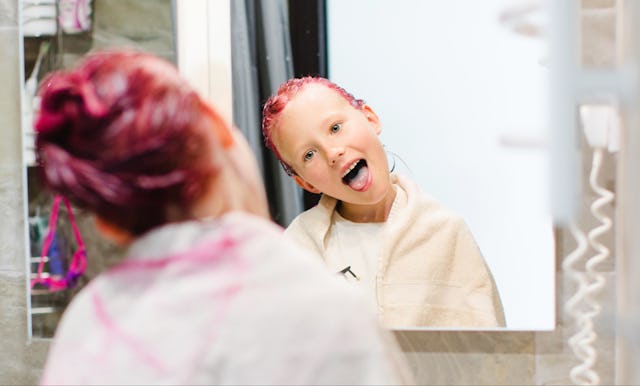How Much Autonomy Should Kids Have Over Their Hair? A Lot, Explains One Therapist
Fuschia hue? Wild cut? Here’s why (and when) you should give your kid leeway with their hair.

Giving your children full autonomy over their appearance is one of the greatest gifts you can offer as a parent, but it’s admittedly sometimes easier in theory than in practice — especially when your tween says they want to dye their hair a rainbow-colored hue or try out a totally drastic haircut. You might worry about whether or not they will actually like going from waist-length strands to a short, cropped cut or what others might say about your kid’s brand new brightly-hued ‘do. But Dr. Courtney Glickman, mental health therapist and founder of The Collective Healing Center, argues in favor of letting your child have full autonomy over their hair.
Why?
Hair is a deeply personal part of your child’s self-expression and, in some cases, their gender exploration. But it’s also just hair, and in the grand scheme of things, your child can change styles and colors if they hate their new look. Plus, it will grow back in time. A unique dichotomy, to be sure, but a potentially important part of shaping your little one’s identity, says Glickman.
How Giving Hair Autonomy Shapes Your Child’s Sense of Self
“Hair is an important part of a child’s identity and sense of self,” says Glickman. “Having autonomy over their hair is about freedom of expression, representation, and respect. As parents, our goal is to raise children in an environment of acceptance, love, and security. We hope they grow into confident people that are authentic and value themselves. Something as simple as letting your child choose their own hairstyle can set the foundation for this to occur. You, as a parent, are modeling your trust in your child’s choices, your unconditional acceptance of them, and encouragement of their individual expression of self. Parenting beyond the binary provides opportunity for children to explore who they are versus who society tells them they should be.”
If you’re wondering when, exactly, you should start giving your child the freedom to explore, Glickman notes that children as young as three or four can be given “some control in their own hair decisions.” Of course, that doesn’t mean you’re giving your toddler free rein of the scissors, clippers, and hair dye, but that’s when you might start giving them some leeway with their hair.
Parents can take small steps, says Glickman, especially with younger kids: “I suggest they pick out different pictures and styles and provide their child with the autonomy to choose out of those options. As they grow older, kids can develop more control in those decisions. Of course, the options offered should take into consideration the child’s desires. If you have a daughter asking for short hair and all of the options provided are long, you are not meeting them where they are. When you allow your toddler to be a part of these choices, you are communicating a deeper meaning — one of consent, boundaries, body autonomy, and security. They have ownership of their body and how they want to express themselves.”
The Implicit Biases Surrounding Hair
However well-meaning you might be as a parent, there’s a good chance you’re dealing with at least some internal biases due to deeply rooted gender and racial social constructs. “It is essential to explore and challenge these biases and part of a healthy decolonization of our ingrained notions related to how we ‘should’ present in our world,” notes Glickman, adding, “I like to ask parents to examine their own gender beliefs when they are struggling with how to accept or support their child’s expression of self through hair, makeup, clothes, etc. Gender is something that cannot be defined by another person. We learn about gender ideas from the people, messaging, and images around us. It is important to explore what parents have learned and how this impacts them in order to process how our society has created delusions of gender that perpetuate rigid, binary beliefs around what it means to be masculine or feminine.”
Even seemingly innocuous commentary about your child’s hair — and yes, this all includes body hair, too — can create lasting ripple effects on your child, especially if they’re exploring their sexuality or gender. “Trying to control or influence your child’s hairstyles can send a disaffirming message,” says Glickman. “For transgender and gender-nonconforming youth, it can even lead to gender dysphoria. Try to reflect on how damaging it can be for a child to be pressured to bend toward conformity rather than feeling accepted as themselves.”
How To Support Your Child
Thankfully, you have all the tools you need to help shape your kid’s identity in a positive, loving way. “Parents can encourage and support their child’s decision when it comes to styling by displaying an affirming stance,” says Glickman. “Many parents express worries around the possibility of their child being bullied. This is understandable given the world we live in. Parents can model setting boundaries with relatives/friends about their commentary towards the child (often coming from a naïve or ignorant stance). Parents can also help find a gender-affirming salon and stylist. Some children may want support in speaking with the hairstylist before the appointment, while others may feel empowered in doing it on their own. Practice open communication and active listening to build independence and mastery over their body, mind, and environment.”
“In the end, it is a crucial aspect of child development to be given the freedom to celebrate who they are,” explains Glickman. “As hair is so deeply connected to race, gender, and overall expression of self, autonomy over hair decisions in the parent-child relationship offers opportunities to connect, encourage, and embrace their budding identities.”
Expert Source:
Dr. Courtney Glickman, mental health therapist and founder of The Collective Healing Center
This article was originally published on